Excerpts from Jim Conrad's
Naturalist Newsletter
Entry dated April 19, 2024, from notes taken about 1.5km northeast of Puerto de los Velazquez, Municipality of Pinal de Amoles; N21.134°, W99.667°, elevation ~2760 meters (~9050 feet); oak/pine forest on limestone bedrock; east-central Querétaro state, MÉXICO
ISOCOMA VENETA

The above subshrub grew in the middle of a large, abandoned field mostly covered with parched, dry-season grass the same dun color as the dead, non-greenish part of the plant, and my dusty shoes; the shoes provide a scale for things. The subshrub's halo-like fringe of dead stem and leaves from previous seasons indicated that the plant was well established.
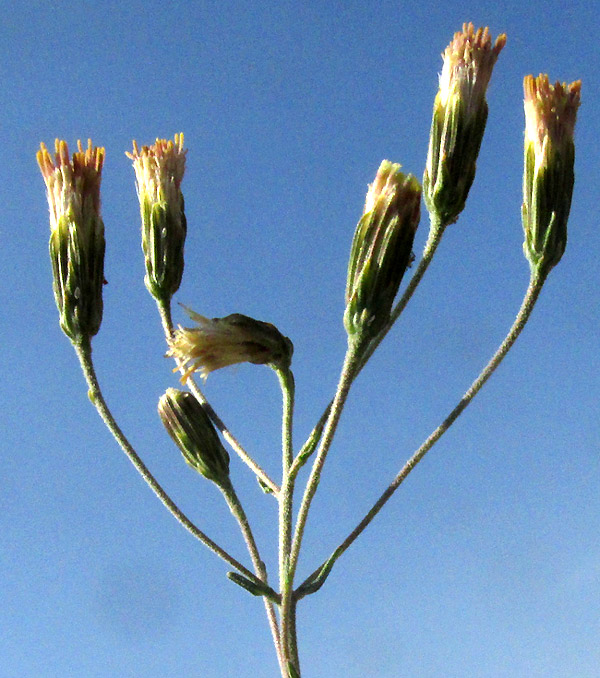
A member of the vast Composite/Aster/Sunflower family, the Asteraceae, the plant was flowering prolifically. At stem tips, flowering heads were arrayed in corymbiform inflorescences. Corymbs arrange their flowers or heads so that the outer ones stand atop longer pedicels than the center ones, resulting in the inflorescence being more or less flat topped.
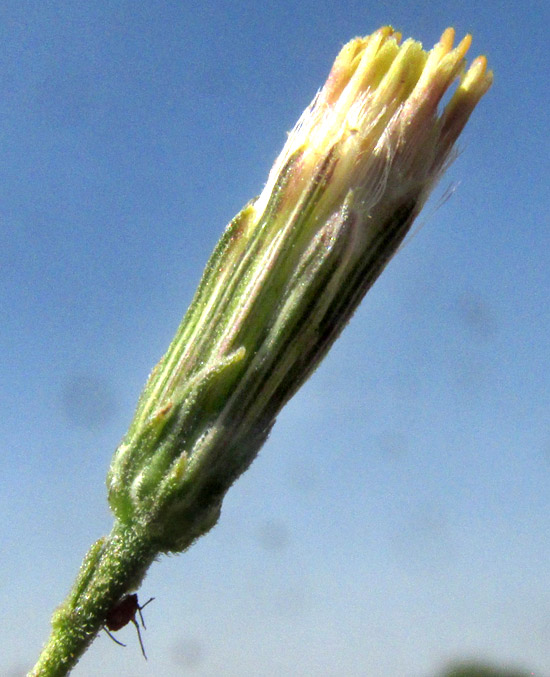
The above flowering head, or capitulum, shows that our plant belongs to that minority of Aster Family genera producing only cylindrical disc florets, with no petal-like ray florets clustered along the margin. The florets are pale yellow. The greenish, vase-shaped involucre inside which the disc florets are gathered consists of slender, scale-like phyllaries of varying lengths, arranged in overlapping spirals.
Once our subshrub was identified and its features were compared with those in pictures of others of the species, the above picture worried me. The capitulum shown there is more slender than in the vast majority of other pictures, though not all. I'm thinking that this probably reflects the fact that this area is experiencing a dry period characterized by the North American Drought Monitor as a D3 Extreme Drought. The drought has been going on for over two years, and the last rainy season never developed. I suspect that our plant is exhibiting its adaptations for severe drought stress.
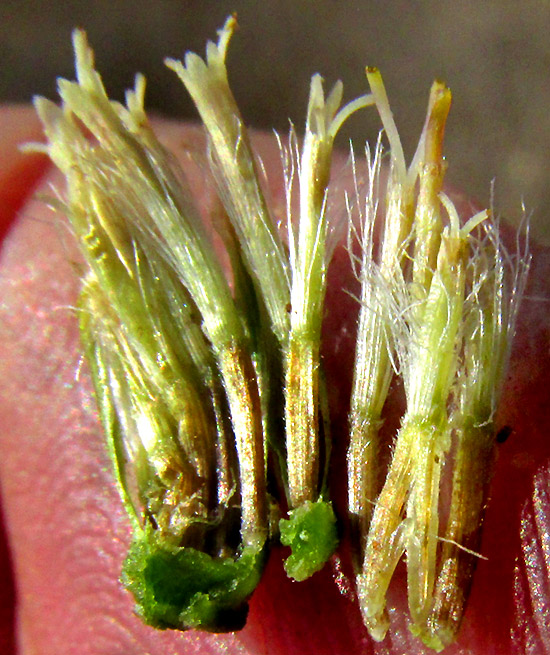
A broken-open capitulum reveals that between each slender, ribbed and short-hairy cypsela-type, one-seeded fruit and the disc corolla above it, there arises a circle of white hairs, which is the pappus. No scale-like paleae are seen separating the cypselae.
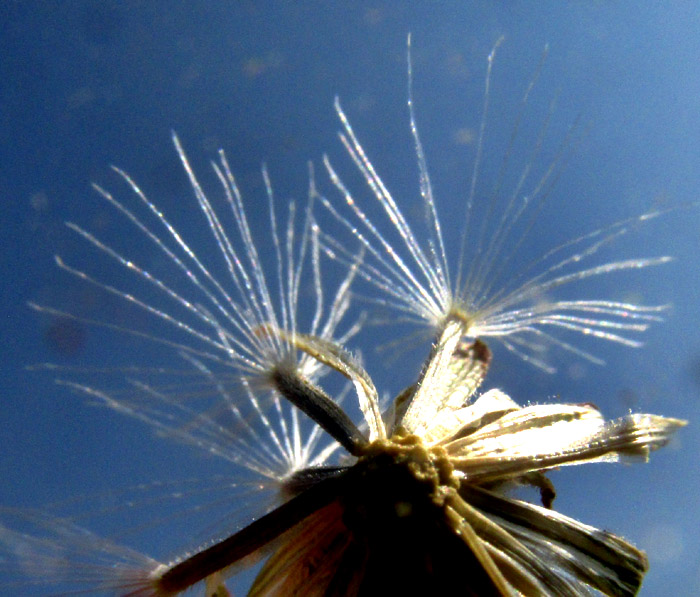
A few heads already had matured to the point of opening up to release their cypselae. Now when wind comes along the cypselae with their pappuses can parachute downwind.
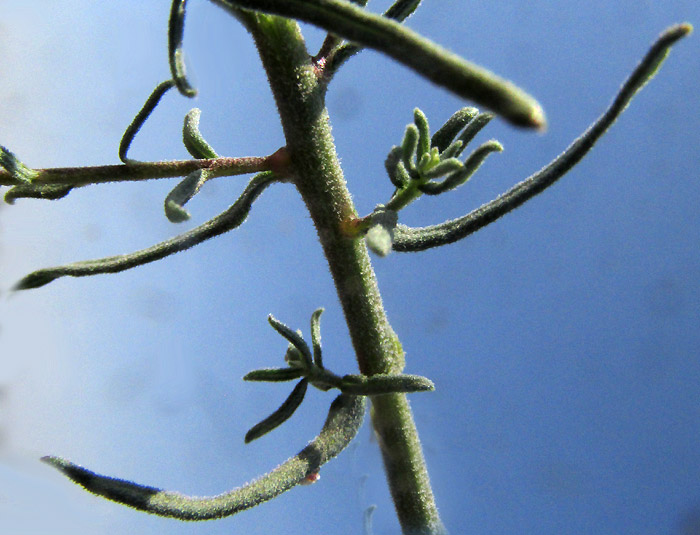
The above picture shows leaves developing just below an inflorescence. In the picture only three long, slender leaves, almost round in cross section, are seen in their entirety. Each leaf arises singly at each stem rode. From the three leaves' axils new stems are arising bearing smaller leaves. The two lower large leaves bear lobes at their bases, and the bottom-most one displays two bumps about ¼ the distance up the blade. These features are noteworthy because most pictures of this species' upper leaves portray flat blades with toothed margins, and those leaves typically yield farther down the stem to deeply lobed, compound-looking blades. A few pictures do show leaves like ours. Once again I'm interpreting features on our plant departing from most shown on the Internet as adaptations for our D3 Extreme Drought.
Still, I'd hesitate to name this plant, except that I can't find any other species occurring in our area displaying our plant's combination of basic features. In our part of upland central Mexico known as the Bajío, if you have an Aster Family member with one toothed or lobed leaf per stem node, the flowering heads produce no ray florets, but the cylindrical, yellow disc florets are gathered within involucres covered with spiraling phyllaries of various lengths, and there are no scale-like paleae separating the florets, you have ISOCOMA VENETA. In Mexico often it's called falsa damiana, or False Damiana, Damiana being a yellow-flowered shrub famed for its use as a flavoring in various traditional Mexican liqueurs.
Isocoma veneta has no English name. It's endemic just to upland Mexico, mostly occurring in disturbed soils, sometimes as a weed, from about the US border south to Oaxaca state.
In the 2016 study by Margarita Micaela Ávila-Uribe and others entitled "Plantas Medicinales en Dos Poblados del Municipio de San Martín de las Pirámides, Estado de México," it's reported that Isocoma veneta is used to cure stomach ache, and for bathing after giving birth.